Technological Development of High Frequency Passive Circuits in Waveguide
The group has proven experience in the technological development of passive circuits (filters, diplexers and multiplexers, distribution networks) used in high frequency communication systems (with special emphasis on space applications) and developed in guided technologies (waveguides, coaxial , metallic cavities with arbitrary 3D geometry and dielectric resonators). This R & D line involves all the necessary stages for the technological development of the above components, i.e. analysis, synthesis and optimized design, prototyping and experimental validation. In each of these areas of activity, progress is made in the following topics:
-
- Development of new techniques for rigorous (full-wave) and efficient electromagnetic analysis of waveguide components, based on modal methods (mode-matching 2D and theory cavities 3D), integral equation techniques and hybrid methods (Boundary Integral – Resonant Expansion Mode, BI-RME 2D and 3D), and integration into Computer-Aided Design (CAD) software packages.
- Practical Management of commercial programs full-wave electromagnetic analysis (available licenses of ANSYS HFSS, Designer ANSYS, AuroraSAT FEST3D, Mician Microwave Wizard and COMSOL Multiphysics) for verification of the own analysis methods and practical design of advanced components.
- Combination of synthesis methods (based on couplings matrices and equivalent distributed models) with optimization algorithms (direct search, gradient, evolutionary and based on space mapping techniques) for computer aided design (CAD / CAE) of passive waveguide components for high frequency.
- Practical design, including prototype manufacturing (with own equipment at the UPV, or at external facilities already validated) and experimental measurements of passive devices (filters, diplexers and multiplexers, splitters, orthomode transducers, polarization rotators, transitions) in several technologies (dual mode filter in circular waveguide, low-pass filters or band-stop in doubly corrugated waveguide, diplexers in comb-line coaxial technology, see photos) for wireless, mobile and space communication systems (VHF, UHF, L , S, C, X, Ku, K, Ka bands).
- Prediction of RF discharge effects (multipaction and corona), which arise in high power applications (eg in satellite payloads and earth stations), using simulations with full-wave EM algorithms and particle physics. Experimental measurements of such phenomena as well as of passive intermodulation (PIM) in our own facilities and in the ones shared with the European Space Agency and the Valencian Space Consortium.
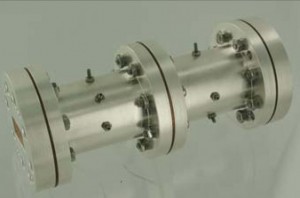 |
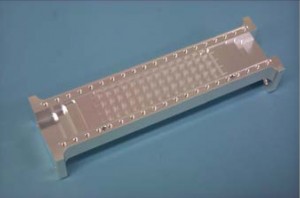 |
| Dual Mode Filter | Doubly Corrugated Filter |
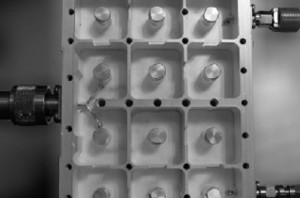 |
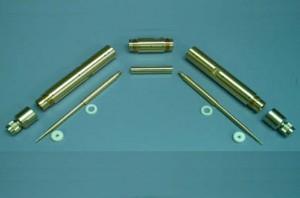 |
| Combline Diplexer | Coaxial Adaptor |
To address the various areas of activity of this R & D line, the group has its own laboratory for full-wave EM simulation of circuit and components (equipped with computer stations, workstations and own and/or commercial software), as well as a class 10,000 cleanroom of 50m2 for experimental measurement of prototypes (electrical response up to 50 GHz with vector network analyzer, see photo below).
At the same time, the group has access to the facilities of the European High Power RF Space Laboratory, managed jointly by the European Space Agency and the Valencian Space Consortium, consisting of a 150 m2 room class 10,000 with all the necessary equipment (vacuum systems, generation and amplification of RF and microwave signals, banks and measuring equipment) to measure effects of RF discharge (corona and multipaction) and passive intermodulation (PIM) in high frequency components (from 435 MHz to 30 GHz ) to board on satellites (see photo and link to lab).
 |
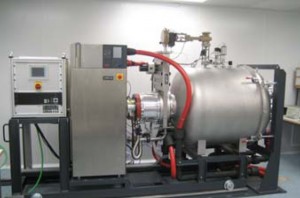 |
| Network Analyzer – 50GHz | Vacuum System |
